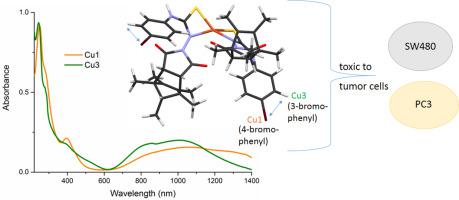Journal of Inorganic Biochemistry ( IF 3.9 ) Pub Date : 2020-08-21 , DOI: 10.1016/j.jinorgbio.2020.111234 Aleksandra Drzewiecka-Antonik 1 , Paweł Rejmak 1 , Marcin Klepka 1 , Anna Wolska 1 , Alicja Chrzanowska 2 , Marta Struga 2

|
A series of nine copper complexes were synthesized by reacting 1,3-disubstituted thioureas with copper(II) chloride. The new compounds were characterized by elemental analysis, infrared, ultraviolet-visible and X-ray absorption spectroscopies as well as molecular modelling. The molecular structure of complexes in the solid state consists of two thiourea ligands chelated to the Cu(II) ion through the S and deprotonated N atoms (CuN2S2). The coordination polyhedron of metal cation in powdered samples exhibits two different geometries. Pseudo-tetrahedral structure is observed for noncentrosymmetric complexes with cis-N2S2 arrangement around Cu(II). A distorted square planar geometry is characteristic for centrosymmetric compounds with trans arrangements of chelating atoms around the central ion. All complexes after dissolving in dimethyl sulfoxide adopt a centrosymmetric coordination, while after diluting this solution with water, the reorganization of atoms around the metal cation is observed, leading to the formation of a tetrahedral compounds.
Initial ligands and Cu(II) complexes were evaluated for their cytotoxicity. Two complexes with 4- and 3-bromophenyl attached to the (1,7,8,9,10-pentamethyl-3,5-dioxo-4-azatricyclo[5.2.1.02,6]dec-8-en-4-yl)thiourea moiety (Cu1, Cu3) are cytotoxic against SW480 and PC3 cells (IC50 4–19 μm), and non-cytotoxic against HaCaT cells (IC50 ≥ 84 μm), being more selective than doxorubicin and cisplatin used as references. The compounds induced apoptosis in cancer cells, however, Cu3 was estimated to be highly active inducer of late apoptosis in SW480 and PC3 cells at lower toxicity against normal cells. The likely mechanism of action of complexes is correlated with decreasing release of IL-6 in cancer cell lines.
中文翻译:

Cu(II) 与多环酰亚胺连接的(溴苯基)硫脲部分的结构和抗癌活性。
通过 1,3-二取代硫脲与氯化铜 (II) 反应合成了一系列九种铜配合物。通过元素分析、红外、紫外-可见光和 X 射线吸收光谱以及分子建模对新化合物进行了表征。固态复合物的分子结构由两个硫脲配体组成,它们通过 S 和去质子化的 N 原子 (CuN 2 S 2 )螯合到 Cu(II) 离子上。粉末样品中金属阳离子的配位多面体表现出两种不同的几何形状。与顺式-N 2 S 2 的非中心对称配合物观察到伪四面体结构Cu(II)周围的排列。扭曲的方形平面几何形状是中心对称化合物的特征,其中螯合原子在中心离子周围呈反式排列。溶解在二甲亚砜中的所有配合物均采用中心对称配位,而用水稀释该溶液后,观察到金属阳离子周围的原子重组,导致形成四面体化合物。
评估了初始配体和 Cu(II) 复合物的细胞毒性。4- 和 3-溴苯基连接到 (1,7,8,9,10-pentamethyl-3,5-dioxo-4-azatricyclo[5.2.1.0 2,6 ]dec-8-en-4- 的两种复合物基)硫脲部分 ( Cu1 , Cu3 ) 对 SW480 和 PC3 细胞具有细胞毒性 (IC 50 4–19 μm),对 HaCaT 细胞无细胞毒性 (IC 50 ≥ 84 μm),比用作参考的阿霉素和顺铂更具选择性. 这些化合物诱导癌细胞凋亡,然而,Cu3估计是 SW480 和 PC3 细胞晚期凋亡的高活性诱导剂,对正常细胞的毒性较低。复合物的可能作用机制与癌细胞系中 IL-6 的释放减少有关。


























 京公网安备 11010802027423号
京公网安备 11010802027423号